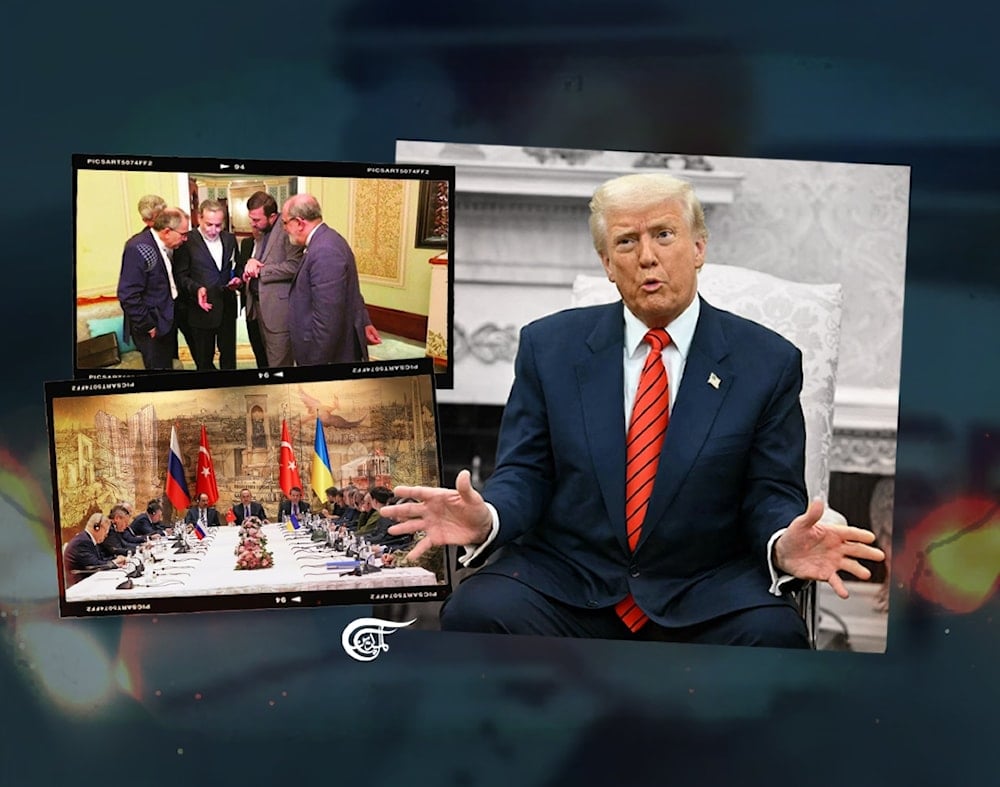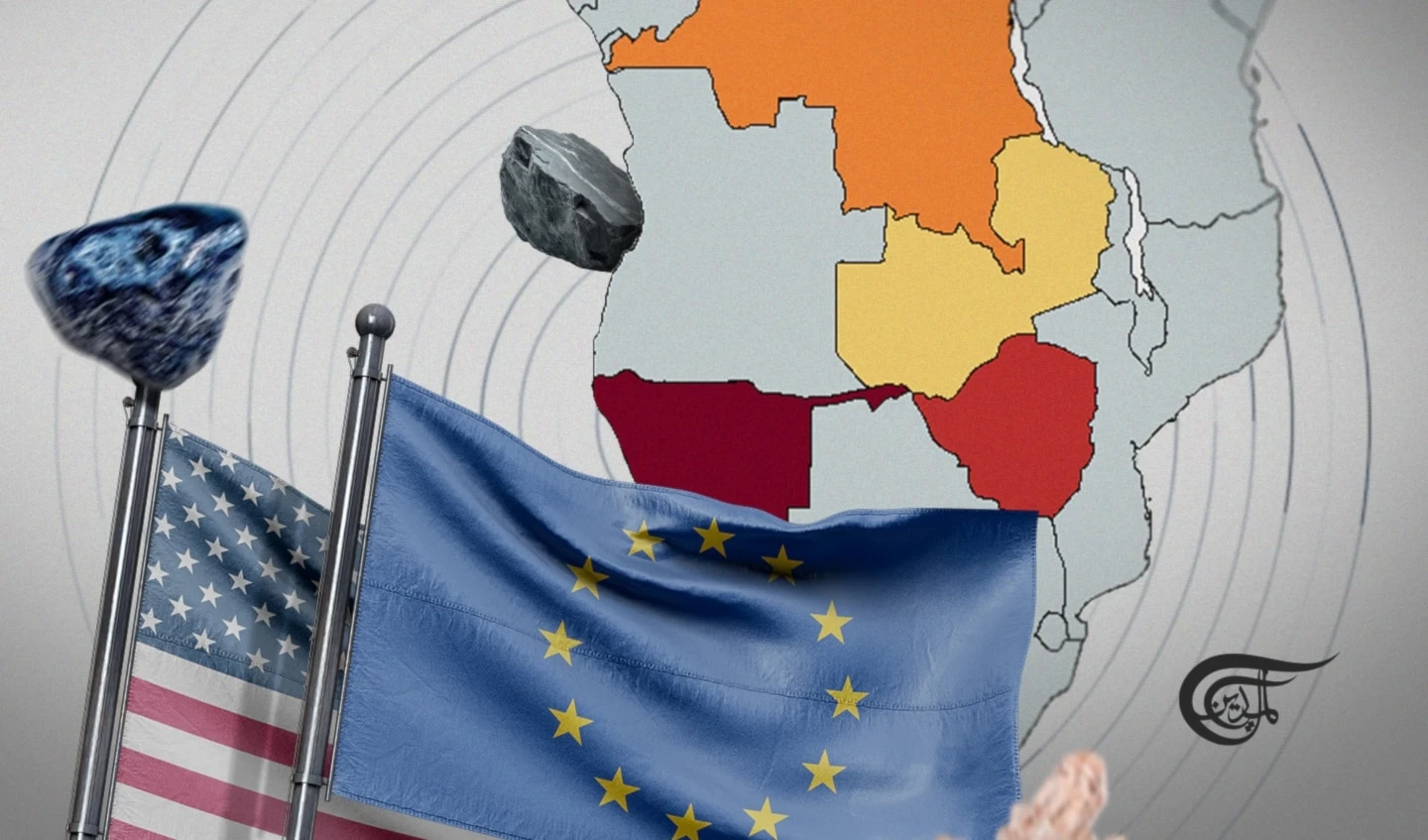What the deep strike on Russia reveals about NATO strategy and Trump’s diplomatic deadlock
The true battleground is no longer just physical, but temporal and symbolic, and in this evolving conflict, Washington may be the most exposed.
-

If one lesson emerges from this moment, it is this: The battlefield now lies as much in the timing of decisions as in the geography of targets. (Al Mayadeen English; Illustrated by Zeinab El-Hajj)
In a global environment marked by accelerating strategic competition, the recent strike deep inside Russian territory emerges as a pivotal moment. Far from being a routine battlefield development, this operation — targeting strategic military sites nearly 4,500 kilometers from the Ukrainian border — signals a shift in the architecture of conflict itself. It is a move with layered implications, not only military but geopolitical, not merely tactical but symbolic.
Crucially, parts of the strike appear to have been launched from within Russian territory, introducing a dangerous precedent: Russia’s homeland is no longer a sanctuary. The event raises critical questions about the depth of NATO’s indirect involvement, and whether this was a Ukrainian initiative alone or part of a broader Atlantic consensus to escalate pressure on Moscow from within.
A Familiar Blueprint
The pattern bears resemblance to earlier incidents in Iran, where high-level assassinations and sabotage operations were executed from inside the country, allegedly by Israeli operatives. "Israel", while not formally within NATO, remains a trusted node in its intelligence and operational networks. Today, Ukraine plays a similar role: a NATO partner executing actions with deep operational implications.
Yet the similarity is not only tactical. In both cases, these operations occurred in the shadow of sensitive, high-stakes negotiations. Iran was engaging Washington on a potential nuclear deal when attacks erupted inside its territory. Now, Russia finds itself in a parallel situation, under the gun while at the table.
Context Is Everything
What elevates the significance of the Russian strike is not just its scale or method but its timing. It came just hours before a planned round of Russian-Ukrainian negotiations, and closely followed US President Donald Trump’s warning that “severe consequences” awaited Moscow should it fail to show flexibility.
This synchronization is no accident. It reflects the continued application of Washington’s pressure-diplomacy dualism, a hallmark of Trump’s approach in both his terms. The goal is to shape negotiations not through persuasion but by coercion, via economic levers, covert action, and symbolic shows of force.
Simultaneously, the US is mounting pressure on Tehran and pushing for a ceasefire in Gaza, moves aimed at crafting a regional environment favorable to a revamped American-led order. What links these seemingly disparate files is a singular objective: securing a string of foreign policy “wins” in the shortest time possible, which Trump hopes to convert into domestic political capital.
Trump and the Tyranny of Time
For President Trump, the clock is not a passive backdrop, it is the battlefield. Over 100 days into his second term, the administration is still searching for a foreign policy breakthrough. The nuclear talks with Iran have made halting progress, but remain unresolved. Despite optimistic briefings, Tehran has resisted US pressure, instead using diplomatic flexibility to stall while holding out for better terms.
In parallel, the Biden-era policy skeleton remains, especially in how Washington mobilizes international institutions to apply pressure. The IAEA’s recent claims, suggesting Iran has enough material for up to 10 nuclear bombs, serve less as factual alarms and more as negotiation tools. Technical oversight becomes political leverage, and the nuclear file becomes an instrument of timing.
Internal Disarray, External Pressures
Inside the White House, Trump’s team is facing disorientation. National Security Advisor Mike Waltz was recently dismissed, replaced by Secretary of State Marco Rubio as the de facto head of national security coordination. A new appointment, instead of Morgan Ortagus, is expected to take over Middle East affairs, reflecting a broader shakeup.
Meanwhile, Elon Musk’s ambitious DOGE project, meant to digitize government operations and reduce bureaucratic waste, has collapsed under its own weight. In public, Musk expressed disappointment in the administration’s failure to embrace technological overhaul. Add to this the judicial defeat of Trump’s tariff strategy - ruled unconstitutional without Congressional approval - and the image of a White House losing ground becomes harder to conceal.
These setbacks have increased pressure on the President to deliver achievements abroad. If domestic avenues are blocked, then foreign policy becomes the arena of redemption.
Russia and Iran: Controlled Resistance
Moscow and Tehran, while facing different threats, are reading the same map. Both understand that Trump seeks resolution, not escalation. Thus, both are playing for time, engaging in talks while holding onto strategic leverage.
For the Kremlin, the strike is a serious violation, but not one that warrants an all-out war. Putin likely sees greater value in managing escalation, targeting Ukrainian infrastructure in response, but avoiding moves that would derail talks altogether.
Indeed, Russia’s negotiating team appeared in the expected round the day after the strike, proposing terms that were firm but not inflammatory. The signal was clear: retaliation is on the table, but diplomacy remains open.
Iran is using similar calculus. Tehran shows openness to dialogue but refuses to concede key strategic demands. Flexibility on uranium enrichment is matched by resolve on sanctions relief and security guarantees. The recent IAEA rhetoric, then, becomes another piece in this calibrated chess match.
Who Wants Chaos? and Why?
Not everyone is eager for Trump’s diplomatic breakthroughs. Within the US establishment and among European allies, there are those who view his realist inclinations - pragmatic engagement with adversaries, rejection of endless wars, transactional alliances - as destabilizing.
For them, halting the march toward settlements with Russia, Iran, or even Hamas is imperative. Disruption becomes strategy. Encouraging escalatory incidents, especially those that force adversaries into reactionary stances, is one way to block deals from crystallizing.
The strike on Russia, then, is not only a blow against Moscow. It’s a blow against a vision of the world order that Trump is attempting to reimpose, one that prioritizes equilibrium over domination, negotiation over confrontation.
Russia’s Calculated Response
Despite the provocation, Moscow’s anticipated response is unlikely to mirror the scale of the strike. Rather, it is expected to take the form of precise retaliatory actions, targeting Ukrainian energy hubs, transport nodes, or communication infrastructure, without crossing thresholds that would collapse the negotiation framework.
The logic is simple: maintain strategic credibility without derailing a process that might, in time, shift the balance in Russia’s favor.
This dual-track response underscores the complex dynamic now at play. Far from a binary of war or peace, the current phase represents a spectrum of pressures, recalibrations, and managed risks. Both Moscow and Washington seem committed, at least for now, to avoiding a full-scale break.
The Broader Arc
Seen in isolation, the strike may appear as just another episode in the long war. But when placed within its wider context of transatlantic maneuvering, US domestic urgency, and the delicate balance of global diplomacy, it becomes something far more telling.
It is a signal. Not only to Russia, but to Iran. Not only to adversaries, but to allies within the West who fear Trump’s potential redefinition of global order. It is a reminder that even as negotiations proceed, the battle for narrative, leverage, and tempo continues unabated.
In the final analysis, we are witnessing not just the evolution of warfare, but the evolution of diplomacy under pressure. The strike on Russia is a symbol of this new terrain, where the line between intelligence and artillery, between deterrence and provocation, is deliberately blurred.
The road ahead will not be determined by firepower alone. It will be shaped by timing, perception, and the willingness of actors, both global and local, to absorb shocks without collapsing the structure.
But if one lesson emerges from this moment, it is this: The battlefield now lies as much in the timing of decisions as in the geography of targets. And in that battlefield, the most vulnerable actor may not be Moscow or Kiev, but Washington itself.

 Nour-Eddine Iskander
Nour-Eddine Iskander
 8 Min Read
8 Min Read








